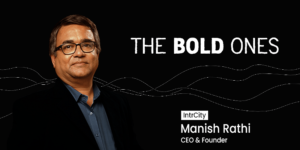‘Your video is buffering…’
There is nothing more frustrating than having a video freeze or stutter in the middle of your favourite scene. In fact, netizens have coined the term ‘buffer rage’ to express their state of anger and frustration that is induced by the delayed or interrupted experience of streaming video content. According to media firm IneoQuest, 51 percent of consumers who watch online or streaming video have been frustrated to the point of “rage” as a result of buffering, which appears to be a major problem in the streaming industry.
But every time that spinning wheel appears on the screen, we all jump in to blame our sluggish internet, when the issue could be more from the streaming provider’s side.
Given the tsunami of video-based content across platforms today, the problem of low quality videos or buffering could heavily cost a brand as the new-generation user is not just impatient but also spoilt for choice.
Delhi-based startup Mogi IO is looking to address this problem for video content platforms, including over-the-top (OTT) media services and broadcasters, edtech platforms and gaming ventures, with the help of its patented technology. The startup is also one of YourStory’s Tech50 2021 companies.
The two-year-old B2B media tech software-as-a-service (SaaS) venture enables content platforms to stream buffer-free videos, and highly compressed content files (videos and images) over their websites or channels for superior customer experience, explains Co-founder Vikrant Khanna. Vikrant has previously served as Chief Operating officer (COO) at Homeshop18 and as Vice President (VP), Consumer engagement and Digital, at Bharti Airtel, where he met serial entrepreneur and his co-founder Rahul Lahoria.
The pivot
Mogi IO finds its roots in founders’ first venture BoomAGift, a virtual gifting app inspired from Korea-based KakaoTalk. Over a span of two years, the startup managed to clock business worth around Rs 13 crore, before the founder decided to “restructure” and pivot.
Vikrant explains how the concept was fairly niche and required a huge amount of marketing expenditure for it to have a mass adoption. “We decided to turn BoomAGift into an AI-enabled short format video app and launched it as Mogi IO, where the consumers could send gifts to content makers to strike a relation or a conversation,” he says.
This was, however, not the end game for the founders, who continued to work on their concept, and in between recognised the technical challenges in the “highly fragmented video industry”. Discontented with what was available in the market, they started building an in-house tech stack for delivering better quality videos.
“The results and outcome that we got from the technology that we built for ourselves were quite startling compared to what was available in the market. It seemed like a breakthrough tech and we subsequently decided to file for a patent in 2019 following a positive response from our peers and investors in the industry,” he says.
The founders relaunched Mogi IO as a B2B (business-to-business) media tech SaaS venture for video content platforms.
A booster shot
The timing worked well for the platform as the Indian market was warming up to online video consumption before massively exploding during the pandemic. According to a study by Bain and Company, the online video user base in India has scaled to more than 350 million people, growing 24 percent between 2018 and 2020, nearly twice as fast as markets such as China and Indonesia.
“While video traffic continues to surge, the global Content Distribution Network (CDN) infrastructure, on which content streaming happens, is falling short of the demand. This leads to network congestion, buffering and CDN outages at times. Mogi has built a patented ‘Streaming Engine’ that uses a Multi-CDN technology to ensure a buffer-free experience that leads to speedy content delivery. The technology compresses the videos by 50 percent better compared to conventional solutions, implying an 50 percent reduction in bandwidth usage and data transfer cost, which results in reducing the bounce rate,” says Rahul.
It also creates automatic redundancies in case of CDN failures so that the viewer experience remains uninterrupted.
The startup onboarded its first client Momspresso within the first weeks of the launch. Since pandemic, it has amassed about 18 clients, including OTTs (Stage), TV channels (Dish TV, Motion Education, TV9, BritAsia TV, Flowers TV), social media news apps (PublicNext), live commerce brands (Bulbul, Swirl, DegPeg, LEO Network), edtech platforms (Fenmo), gaming startups (WTF Sports), content creators, local cable operators, and so on.
The subscription-based platform charges $600 per month for its enterprise solution. The charges can vary depending on the bandwidth consumption. The startup clocked an annual recurring revenue (ARR) of Rs 2 crore and has, so far, raised $0.33 million from Pune-based Pentathlon Ventures. It is on a lookout to raise a fresh round in the tune of about $2 million.
Expanding offerings
Besides offering the video and image technology to enterprises, Mogi has recently launched a white-label OTT solution for content owners who do not have a platform to reach their audience.
Terming it as “Shopify for content owners”, the startup has built a plug-and-play SaaS platform which enables anyone to launch their own “self serve” OTT video app instantly. The use case can vary from a Yoga teacher to an astrologer to a short film maker who can launch their branded website or an Android app, design their playlists and start monetising on the videos via subscription or ad revenue streams.
Since its launch in October, the startup has onboarded 35 clients across India and is looking to significantly increase this number in the near future.
“We expect 70 percent of our revenue to come from the retail OTT segment in the next future,” he says.
A global play
On the enterprise side, Mogi faces competition from global names like cloud-based online video solution provider Brightcove, Livestream, Deltatre and video sharing platforms Vimeo, all-in-one OTT Platform provider Muvi on the retail offering side.
“We have a first mover’s advantage in India. Our major USP (unique selling point) is our self-serve tool, where the users don’t have to go through demos or the enterprise selling route. They are not offering a pure play retail product. Affordability is another big factor,” says Vikrant.
Following a subscription-based revenue model, Mogi charges a monthly fee of $40 (Rs 3,000) for its retail solution while the one offered by Vimeo, Muvi or uPlayer start at $299 (Rs 22,000) per month, which keeps increasing as the number of subscribers go up. Vikrant highlights that the startup is able to offer low prices on the back of its patented technology which “radically” brings down the streaming costs.
“We plan to create a world-class software and video tech company from India in the long run, that can empower millions worldwide to access buffer free streaming and, second, help millions of content owners launch their own OTT apps.”
The startup is targeting an ARR of $30 million in the next three years besides exploring the global market.
With increasing video penetration and streaming, Mogi seems to have tapped into the right market.The global video streaming market size is expected to grow from $419.03 billion in 2021 and reach $932.29 billion by 2028, exhibiting a compound annual growth rate (CAGR) of 12.1 percent during the forecast period, according to a report by consultancy Fortune Business Insights.

![You are currently viewing [Tech50] From Yoga teacher to film makers, video tech startup Mogi I/O aims to help users launch their own OTT app in 24 hours](https://blog.digitalsevaa.com/wp-content/uploads/2021/12/CopyofImageTaggingNewBrandingEditorialTeamMaster-1640170492410.jpg)








